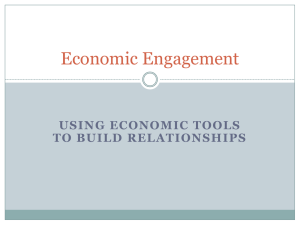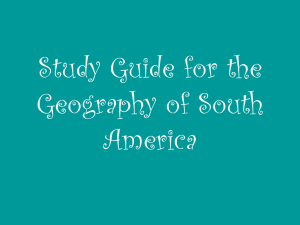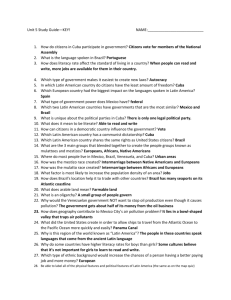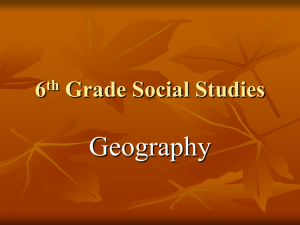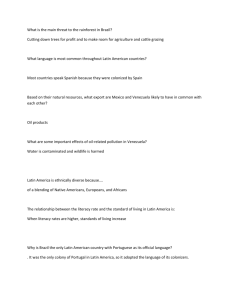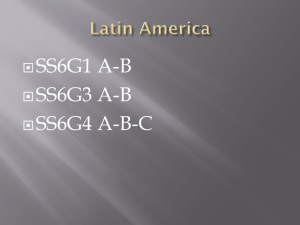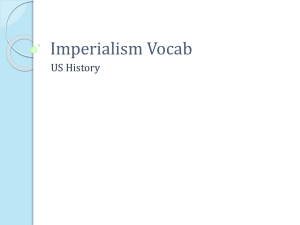SS6 Unit 1: Latin America
advertisement
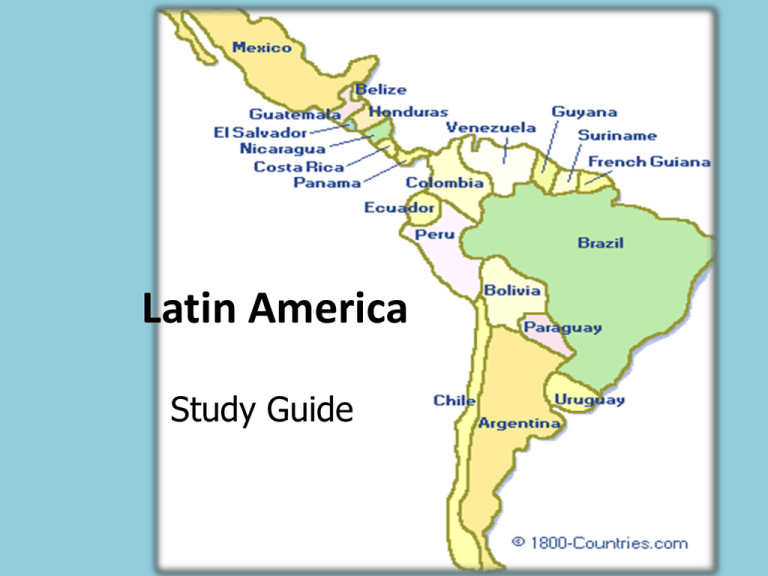
Latin America Study Guide 1. Which is found near the ”1” on the map? a. Panama Canal b. Atacama Desert c. Andes Mountains d. Sierra Madre Mountains 2. Which number on the map marks the country of Cuba? Map at the right: a. 2 b. 3 c. 5 d. 6 3. What are the main sources of air pollution in Mexico City? a. intense sunlight b. the high altitude c. factories and cars d. cars that produce little or no air pollution 4. Which is a problem associated with deforestation? Deforestation means to clear forests or tress. a. More oxygen is available on the planet. b. Poor people earn money from selling trees. c. Native people have too much forest for their needs. d. There is less forest to produce goods that humans need. 5. What trend is there in deforestation after 2004? a. The amount of deforestation is going up. b. The amount of deforestation is going down. c. Deforestation levels have stayed about the same. d. Deforestation levels are lower than they were in the 1980s. 6. What problem has been caused by oil production in Venezuela? a. About 15 percent of U.S. oil comes from Venezuela. b. The coast along the Caribbean Sea has been polluted with oil. c. Lake Maracaibo has become the largest lake in South America. d. Venezuela is less polluted than other South American countries. 7. Which region of Mexico has the most people? a. Central Plateau which contains more urban areas b. northern deserts because it does not rain too much c. tropical beaches that are popular tourist destinations d. Sierra Madre Mountains where farming is more difficult 8. Which is a negative result of Venezuela’s oil business? a. Health care services have improved. b. Pollution has damaged the air and land. c. Education for poor children has improved. d. Road and telephone networks have been expanded. 9. Where do most Brazilians live in their country? a. b. c. d. in the interior along the Amazon River in the Amazon rain forest along the eastern coastal area 10. What has been the major export for Cuba for the past two hundred years? a. b. c. d. fish fruits sugar coffee 11. Which country supported Cuba until 1991? a. b. c. d. Canada Venezuela Soviet Union United States 12. What are the three main sources of the cultural groups of Latin America and the Caribbean? a. b. c. d. Africans, Mulattoes, Catholics Africans, Europeans, Native Americans Mestizos, Native Americans, Europeans Native Americans, Mulattoes, Europeans 13. What are the two primary language of Latin America? a. English and French b. French and Spanish c. Portuguese and English d. Spanish and Portuguese 14. On what common language are the languages of Spain and Portugal based? a. Spanish b. Portuguese c. ancient Latin d. ancient German 15. Why does the term Latin America fit as a description for the regions of Central and South America and the Caribbean? a. The people in these countries speak Latin. b. The countries share similar histories and culture. c. The people in these countries speak languages that come from Latin. d. The countries share similar histories and culture, and they mostly speak languages based on Latin. 16. Why do some countries have higher literacy rates for boys than for girls? a. Boys enjoy learning to read and write more than girls do. b. Girls enjoy learning to read and write more than boys do. c. Some cultures believe that it is not as important for girls to learn to read and write as it is for boys. d. Some cultures believe that it is not as important for boys to learn to read and write as it is for girls. Use timeline above to answer question 24: 17. Which statement describes the economy of Brazil? a. Brazil has a pure market economy. b. Brazil has a pure command economy. c. Brazil is mostly a market economy, but the government does control some businesses. d. Brazil is mostly a command economy, but the government allows some farmers to sell some of their goods on their own. 18. What did Atahualpa hope to keep when he gave away 24 tons of gold and silver to Pizarro? a. b. c. d. his life his family his palace his empire 19. What was the Columbian Exchange? a. sending food and people from the Old World to the New World b. sending animals and plants from the Old World to the New World c. the moving of animals, plants, people, and diseases from Central and South America to North America d. the moving of animals, plants, people, and diseases from the Old World to the New World and from the New World to the Old 20. Which foods came to Europe from Central and South America? a. b. c. d. peaches, coffee, corn, wheat coffee, peaches, sugar, wheat coffee, sugar, cocoa, peaches corn, peppers, potatoes, tomatoes 21. Where did Europeans in the sixteenth century find a cheap labor source for work in the New World? a. slaves from Africa b. settlers that came from Europe c. peasants from Spain and Portugal d. indigenous people of Central and South America 22. Which is one reason Europeans chose slaves from Africa as a labor source in the New World? a. The New World had diseases that did not affect African workers. b. European workers did not know how to do farm and mining work. c. Indigenous people were in short supply due to warfare and disease and Africans were skilled farmers and metalworkers. d. Settlers from Europe did not know how to operate large plantations. 23. Which two European countries contributed most to the languages of Latin America? a. b. c. d. England and Spain Spain and Portugal France and Portugal England and Portugal 24. What is the most common religion of Latin America? a. b. c. d. Creole Aymara Quechua Roman Catholic 25. What was the main job of the priests, friars, and monks sent by Spain to the New World? a. b. c. d. find food and shelter for the poor convert the Indians to Christianity build missions to serve the settlers minister to the armies of the Spanish king 26. Which important goal did Toussaint L’Ouverture want to achieve? a. freedom for the slaves in Saint Dominique b. improved production on sugar cane plantations c. control of the French, Spanish, and British armies in the Caribbean d. a meeting with the French government in France to get better working conditions 27. Simon Bolivar was known as the liberator for which people? a. b. c. d. Mexicans Spanish soldiers South Americans Indigenous people 28. Which country got its independence because of Simon Bolivar’s efforts? a. b. c. d. Canada Mexico Venezuela United States 29. Miguel Hidalgo was known as the father of independence for which country? a. b. c. d. Peru Bolivia Mexico Venezuela 30. Who took over as dictator of Cuba in 1959? a. b. c. d. Fidel Castro Raul Castro John F. Kennedy Fulgencio Batista 31. What was one reaction the United States had to Cuba taking over property owned by Americans? a. The United States threatened a nuclear attach. b. The United States put an embargo of Cuban goods c. the United States wanted Cuba to trade with other countries. d. An agreement was reached to limit the number of Cubans entering the United States. 32. Which country helped Castro build Cuba into a communist country? a. b. c. d. Mexico Venezuela Soviet Union United States 33. The Zapatistas did not like NAFTA because they believed it would… a. mean U.S. factories would move to Mexico. b. force Mexicans to move to the United States. c. hurt businesses in Canada and the United States. d. cause poor Mexican farmers to go out of business. 34. Which group do the Zapatistas support? a. Canadian farmers b. U.S. factory workers c. indigenous people of Mexico d. poor farmers in North America 35. What did Zapatistas do to show they were against NAFTA? a. attacked government troops in Mexico City b. took over several towns in southern Mexico c. formed friendships with groups in other countries with similar goals d. worked with the government on agreements to improve the rights of poor Mexicans
